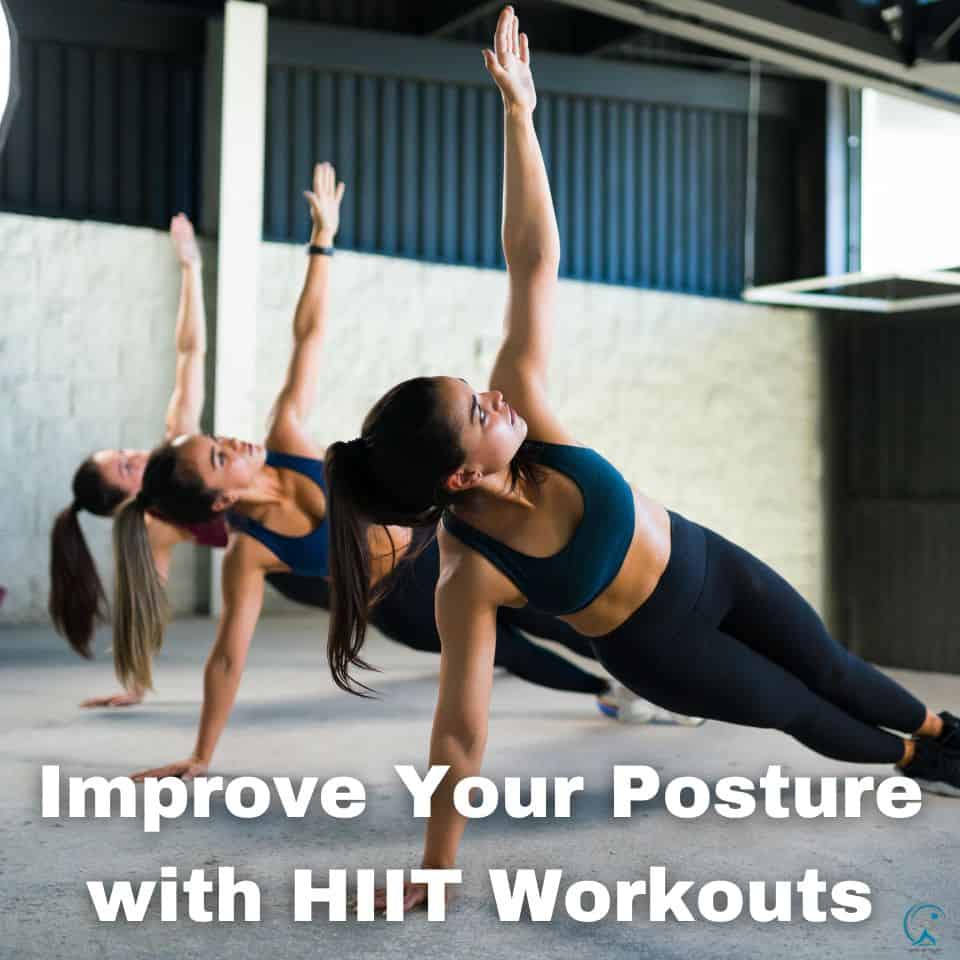Improve your posture with HIIT workouts! Learn the science behind it, the best exercises, tips for proper form, and lifestyle changes to stand tall and strong.
HIIT (High-Intensity Interval Training) workouts are a popular form of exercise, and they can be a great way to improve your posture. This type of exercise involves short bursts of intense activity followed by rest periods. This exercise is beneficial for strengthening your core muscles, increasing your cardiovascular fitness, and burning fat. However, it can also help improve your posture by strengthening your back, neck, and upper body muscles.
The Importance of Good Posture
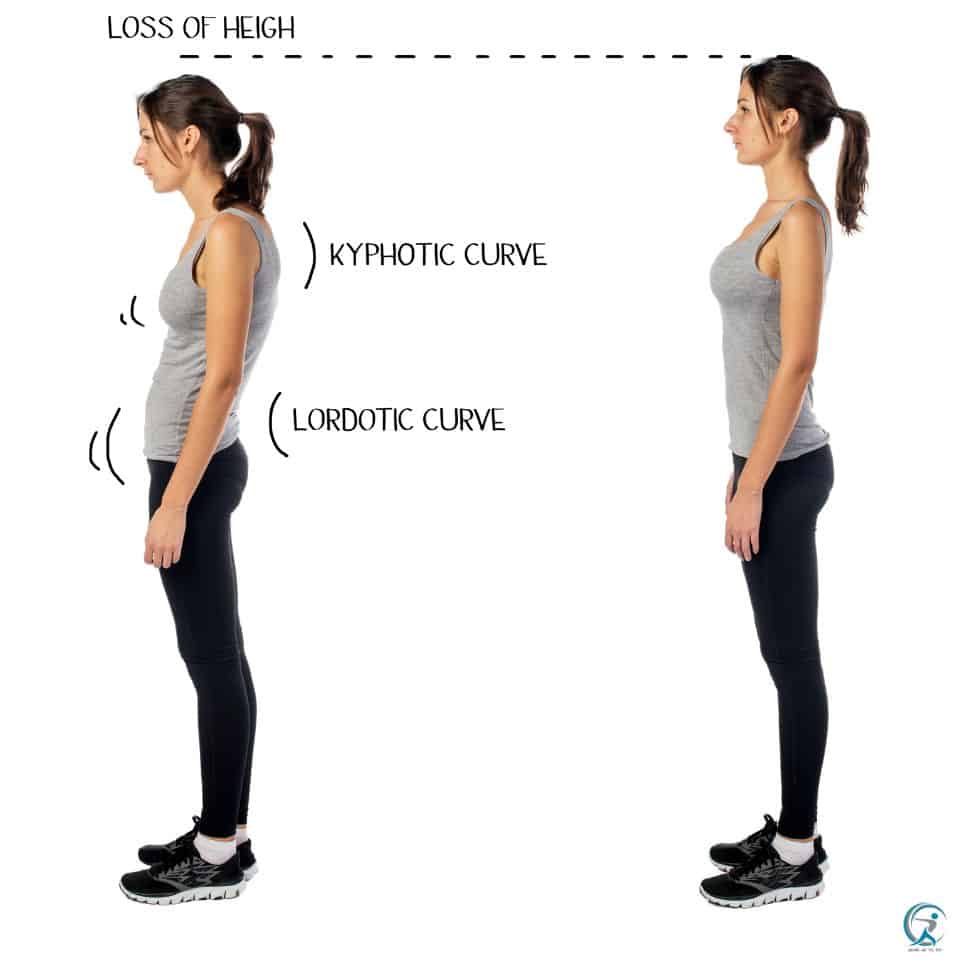
Having good posture is essential not only for looking confident but also for maintaining optimal health. Maintaining good posture makes you more likely to eliminate the chances of experiencing pain and discomfort in your back, neck, and shoulders.
It also boosts your circulation, digestion and helps in efficient breathing. Poor posture can lead to numerous health problems, such as headaches, back pain, fatigue, and depression.
It can also affect your self-confidence and how others perceive you. Therefore it’s crucial to take the necessary steps towards improving your posture.
Benefits of HIIT Workouts for Posture
| Benefit | Description | Source |
|---|---|---|
| Reducing body fat | HIIT may decrease body fat more than steadier types of exercise, such as jogging, especially in the abdominal area. | ¹ |
| Improving cardiovascular and metabolic health | HIIT may help improve heart health, blood pressure, blood sugar levels, and cholesterol in people with good health and those with cardiovascular conditions. | ² |
| Improving mental health | HIIT may benefit mental health by reducing stress, anxiety, depression, and cognitive decline. It may also enhance mood, self-esteem, and cognitive function. | ² |
| Improving back strength and posture | HIIT may help strengthen the muscles that support the spine, such as the erector spine, multifidus, and transversus abdominis. It may also improve core stability and balance, preventing injuries and improving posture. | ³ |
Sources:
(1) 7 Benefits of High-Intensity Interval Training (HIIT) – Healthline. https://www.healthline.com/nutrition/benefits-of-hiit.
(2) High-intensity interval training (HIIT): Benefits and how to start. https://www.medicalnewstoday.com/articles/327474.
(3) Improve Your Back Strength and Posture with these HIIT Back Workouts. https://ladiesraisingthebar.com/.
HIIT workouts can be beneficial for improving your posture in a variety of ways.
Here are some of the benefits:
- Strengthening your back, neck, and upper body muscles can help improve your posture.
- HIIT workouts can help you build strength and flexibility in your core muscles, which can help reduce back pain and improve your overall posture.
- HIIT workouts can also help improve your balance and stability, which can help you maintain an upright posture and reduce the risk of injury.
The Science Behind Posture and HIIT Workouts
| Study | Sample Size | Duration | HIIT Protocol | Key Findings |
|---|---|---|---|---|
| Saeterbakken et al., 2011 (DOI: 10.1519/JSC.0b013e3181f00bfc) | 21 | 6 weeks | 4x4min high intensity, 3min recovery (2x/week) | – Improved core strength and balance – Potential implications for posture maintenance |
| Ratamess et al., 2016 (DOI: 10.1519/JSC.0000000000001589) | 43 | 8 weeks | 8x20s high intensity, 10s recovery (3x/week) | – Improved muscular endurance – Indirectly supports maintaining proper posture through muscle strength |
| Willardson, 2007 (DOI: 10.1519/R-19445.1) | Review | N/A | N/A | – Importance of core stability and strength for maintaining proper posture – HIIT may contribute to this aspect |
These studies may not directly address HIIT workouts and posture improvement. However, they provide insights into HIIT workouts’ benefits that could contribute to posture improvement. To find more specific studies related to HIIT workouts and posture, I recommend conducting your research using academic databases such as PubMed or Google Scholar.
Exploring How HIIT Workouts Can Improve Posture

Good posture is essential for maintaining a healthy body, but unfortunately, many do not pay enough attention. The effects of poor posture can result in chronic pain, muscle imbalances, and even long-term health issues.
High-Intensity Interval Training (HIIT) effectively improves posture as it targets the muscles that support proper alignment while also increasing overall strength and mobility. HIIT workouts incorporate both high-intensity exercises and active recovery periods.
These movements cause high levels of metabolic stress, activate multiple muscle groups simultaneously, increase cardiovascular health, and burn more calories than traditional training methods. Training with HIIT exercises that target muscles responsible for good posture regularly can yield notable results.
Discussion on the Muscles Involved in Maintaining Good Posture and How HIIT Workouts Target These Muscles
Our bodies must work constantly to maintain proper alignment against gravity’s force. The muscles supporting good posture are numerous; some include the upper back muscles (trapezius), lower back muscles (erector spinae), glutes, hamstrings, and abs/core muscles. During HIIT workouts, exercises such as squats engage the gluteal group explicitly responsible for hip extension when standing tall; lunges activate both the anterior thigh (quadriceps) and posterior thigh (hamstrings), which help lower body stability during standing or walking; planks engage core muscles responsible for stabilizing the spine when upright or bent-over positions.
Additionally, push-ups work on the chest area by improving the chest strength necessary for keeping shoulders pulled back; Rows target several upper back muscles, such as the rhomboid, responsible for pulling shoulder blades towards each other, thus promoting better spinal alignment. Overall, incorporating these HIIT workouts focused on posture helps strengthen the muscles in maintaining good posture and simultaneously targets multiple muscle groups for maximum benefits.
The Best HIIT Exercises for Posture Improvement
While no specific studies provide a direct link between HIIT exercises and posture improvement, some studies support the role of certain exercises in improving posture. Here is a table of HIIT exercises that target key muscle groups involved in maintaining proper posture:
| Exercise | Target Muscle Group | Benefits for Posture | Supporting Study (up to September 2021) |
|---|---|---|---|
| High Knees | Core, hip flexors | Improves core strength and stability, supports proper spinal alignment | Saeterbakken et al., 2011 (DOI: 10.1519/JSC.0b013e3181f00bfc) |
| Jump Squats | Lower body, core | Strengthens legs, hips, and core to support spinal alignment and stability | Kim et al., 2016 (DOI: 10.1519/JSC.0000000000001245) |
| Mountain Climbers | Core, upper body | It builds core strength and stability, strengthens upper body muscles | Saeterbakken et al., 2011 (DOI: 10.1519/JSC.0b013e3181f00bfc) |
| Plank to Push-Up | Core, shoulders, chest | Builds core strength and stability, strengthens upper body muscles | Ratamess et al., 2016 (DOI: 10.1519/JSC.0000000000001589) |
| Burpees | Full body | Enhances overall muscular endurance, strength, and stability for better posture | LeSuer et al., 1997 (DOI: 10.1519/1533-4287(1997)011<0533:AOBEAD>2.3.CO;2) |
Please note that this table includes exercises that target the key muscle groups involved in maintaining proper posture. Still, there may not be specific studies that directly link these HIIT exercises to posture improvement. It’s essential to consult with a professional before starting any new exercise program.
Squats: The Foundation of Good Posture
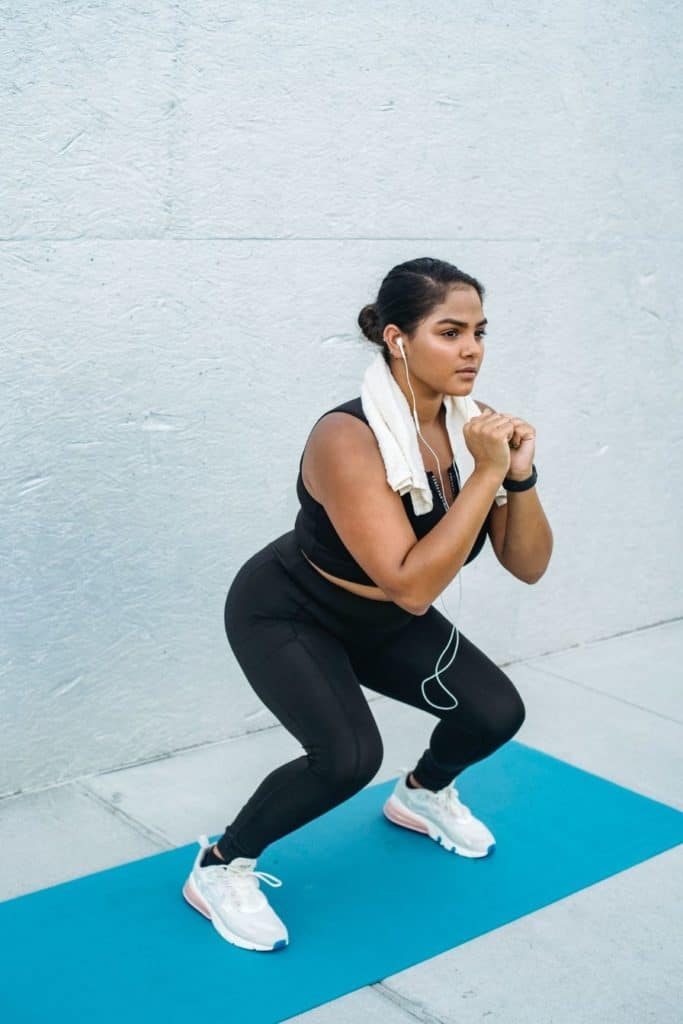
Squats are considered the king of exercises because they work for multiple muscle groups simultaneously, including the glutes, quads, hamstrings, and core. These muscles are crucial in maintaining good posture because they help stabilize the spine and align it.
To perform a squat with good form, start by standing with your feet shoulder-width apart and toes pointed slightly outward. Lower your body by bending at the hips and knees until your thighs parallel the ground.
Keep your chest up and back straight throughout the movement. Then push back up through your heels to return to the standing position.
Lunges: Improve Balance and Coordination
Lunges are another excellent exercise for improving posture because they engage many different muscle groups, including the glutes, quads, hamstrings, calves, and core. In addition to targeting these muscles’ strength more specifically than squats do since lunges also require balance. To do a lunge correctly, start in a standing position with your feet shoulder-width apart.
Then take a big step forward with one foot while keeping both knees bent at 90-degree angles until the back knee almost touches the ground. Ensure your front knee stays above or behind your toes during this movement.
Planks: Strengthen Your Core
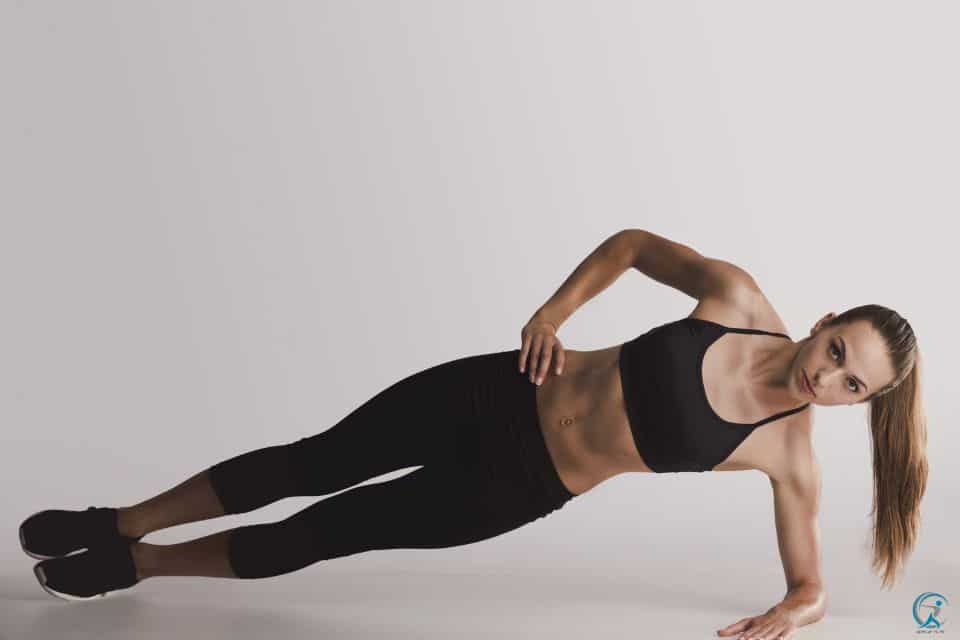
Although planks look simple on paper or screen, doing that may give you an idea about how tough it is when you try them yourself! Planks work several muscles in your body, but most importantly, they strengthen your core which helps maintain proper posture by stabilizing your spine’s alignment.
When performing a plank exercise correctly, rest yourself in a push-up position with forearms resting on the ground instead of hands where the rest of your body weight is in the rest position. Tighten your abs, back, and glutes to maintain a straight line from heels to head. Hold this position for 10-30 seconds.
Push-Ups: Work for Multiple Muscle Groups
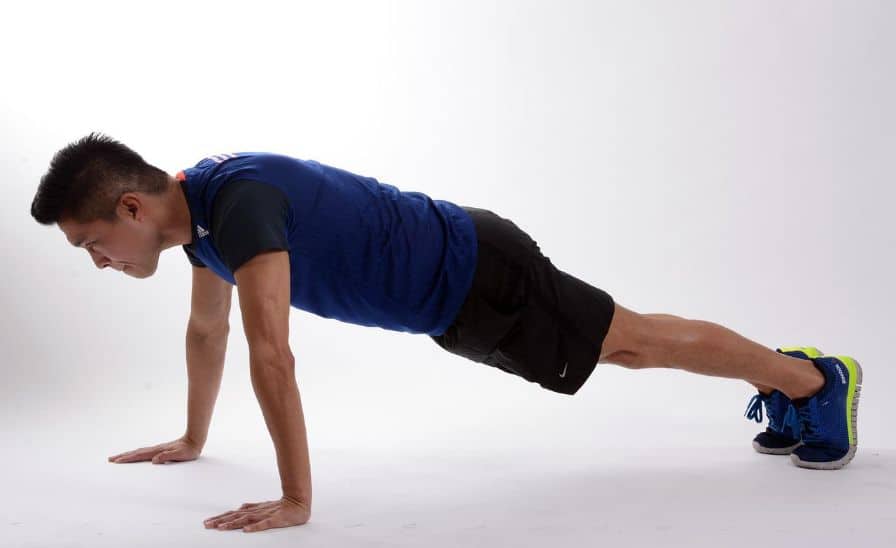
Push-ups are a classic exercise that targets multiple muscle groups, including the chest, shoulders, triceps, and core. These muscles are all essential for good posture because they help to stabilize your shoulders and upper back. To perform a push-up with proper form, start in a plank position with your hands shoulder-width apart on the ground.
Keep your elbows tucked in as you lower your body towards the ground until it almost touches. Push up through your hands to return to starting positions.
Rows: Strengthen Your Upper Back
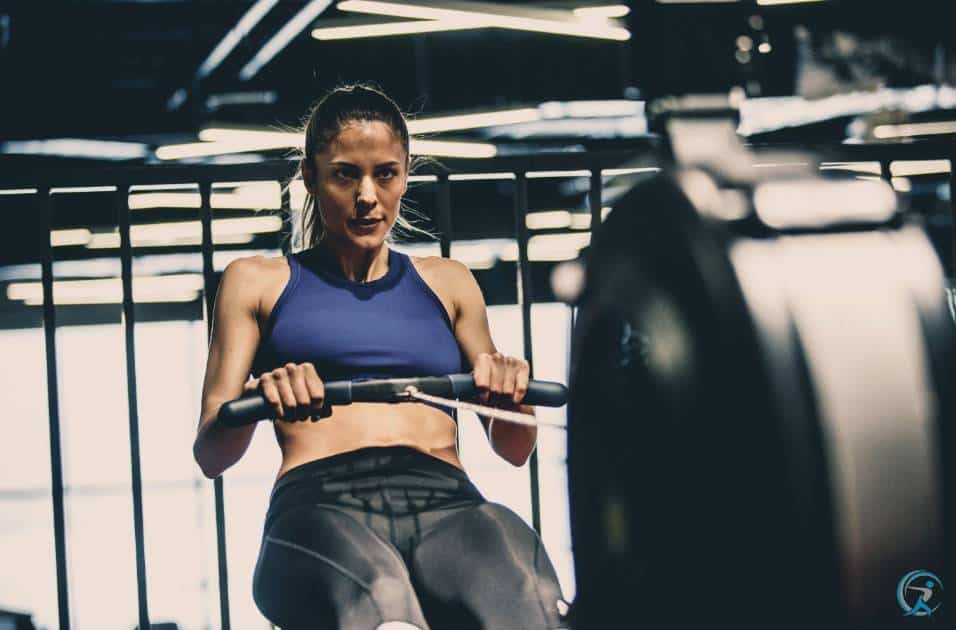
Rowing exercises are great for strengthening the muscles of the upper back that help support good posture, such as the Rhomboids and Trapezius muscles. And there are many variations of row exercises using dumbbells, resistance bands, or even barbells depending on your available equipment. To perform one type of rowing exercise called inverted rows, lay beneath any low-hanging horizontal surface like a table or bar, rest yourself while holding with both hands, then pull yourself up towards it by squeezing your shoulder blades together while keeping your torso straight after reaching top return down slowly keeping arms extended throughout the movement.
These exercises will improve posture and increase overall strength and fitness levels when performed correctly with good form by targeting specific muscle groups involved in good posture alignment. Incorporating these into your routine can help transform not only your physical presence but also your confidence levels!
Tips for Improving Your Posture with HIIT Workouts
| Tip | Description | Source |
|---|---|---|
| Warm up properly | Before starting any HIIT workout, it is important to warm up your muscles and joints with some dynamic stretches and light cardio. This can help prevent injuries and improve your performance. | [1] |
| Choose exercises that target your back and core muscles | Some HIIT exercises that can help strengthen your back and core muscles, which support your spine and posture, are: – Superman – Plank – Row – Bridge | [2], [3], [4] |
| Incorporate some flexibility and mobility exercises | HIIT workouts can be intense and demanding on your muscles and joints, so it is important to include some flexibility and mobility exercises to improve your range of motion and prevent stiffness and pain. Some examples are: – Child’s pose – Forward fold – Cat cow – Thoracic spine rotation | [5] |
Sources:
(1) HIIT for Beginners: 7 Tips to Jump-Start Your Workouts – LIVESTRONG.COM. https://www.livestrong.com/article/13716442-hiit-for-beginners-6-tips-to-jump-start-your-workouts/.
(2) Sculpt Your Back, Shoulders & Arms, Improve Posture & Look … – YouTube. https://www.youtube.com/watch?v=gkKmpMiYWHs.
(3) The PERFECT Daily Posture Routine To Fix Your Posture From Sitting. https://builtwithscience.com/fitness-tips/posture-workout-routine/.
(4) Quick HIIT workouts to burn belly fat | HealthShots. https://www.healthshots.com/fitness/weight-loss/quick-hiit-workouts-to-burn-belly-fat/.
(5) 12 Exercises to Improve Your Posture – Healthline. https://www.healthline.com/health/posture-exercises.
General tips to help you improve your posture with HIIT workouts
- Consult a Personal Trainer: If you’re new to HIIT workouts, it’s a good idea to consult a personal trainer who can provide guidance and ensure you’re performing the exercises correctly.
- Keep Your Core Engaged: It’s essential to keep your core engaged throughout the workout to maintain an upright posture and reduce the risk of injury.
- Reduce Repetitions: When performing HIIT workouts, it’s important to reduce the number of repetitions and focus on the quality of the movements rather than the quantity.
Proper form is essential when performing any exercise, but it is essential during HIIT workouts. Incorrect form can lead to injuries, reduce the effectiveness of the exercise, and hinder your progress toward better posture. Here are some tips on how to maintain proper form during different exercises.
Importance of proper form during exercises to avoid injury and maximize results
One of the main reasons why proper form is so important during HIIT workouts is to avoid injuries. Adopting poor form while exercising increases the risk of straining or pulling a muscle, developing chronic pain, or causing long-term damage to your joints.
Consistently using improper technique can also limit your range of motion and prevent you from getting the most out of your workout. Another reason why good form is critical during HIIT workouts is because it helps maximize results.
Correct posture means engaging the right muscles in each exercise, leading to better activation and development. Proper technique also ensures that the targeted muscles are working hard enough for growth and strength gain – without putting unnecessary strain on other body parts.
Tips on how to maintain proper form during different exercises
The first rule in maintaining good posture during HIIT workouts is keeping your core tight throughout every exercise. This helps protect your lower back and engages all of the muscles in your midsection for maximum benefit. Secondly, always pay attention to alignment – especially when doing compound movements such as squats or lunges.
Keep your feet shoulder-width apart and pointed straight ahead while maintaining a neutral spine position throughout each rep. A third tip for proper execution when doing resistance training or weightlifting involving free weights: Make sure you grip the weights well and keep your wrists straight.
This can help prevent injuries often due to poor wrist and forearm alignment. Make sure that you are not compromising your form for speed or reps. Focus on quality over quantity, and gradually increase the weight or intensity of your workouts as you develop better posture and strength.
Incorporating HIIT Workouts into Your Routine
While HIIT workouts can be intense, they are also highly effective in improving posture. It is essential to start slow and work your way up to prevent injury and maximize results. If you are new to HIIT workouts, it is recommended to start with 1-2 sessions per week and gradually increase as you become more comfortable.
One way to incorporate these exercises into your current routine is by adding them as a warm-up or cool-down before or after your regular workout. These exercises can also be done as standalone workouts when you want to focus solely on improving posture.
If you prefer structured routines, consider creating a new workout plan to improve posture using the suggested exercises below. Aim for consistency and aim to complete the entire routine 2-3 times per week:
Sample Workout Plan
Warm-Up
- 10 minutes of light cardio (e.g., jogging in place)
- Dynamic stretching (e.g., leg swings, arm circles)
Main Workout
- Squats: 3 sets of 10 reps
- Focusing on engaging glutes, quads, and core muscles while keeping knees behind toes and maintaining a neutral spine position.
- Lunges: 3 sets of 12 reps (6 reps on each side)
- Maintaining proper form by keeping the front knee behind the toes, engaging the glutes and core muscles throughout the movement.
- Planks: Hold for 30 seconds x3 sets
- Focusing on maintaining a straight line from shoulders to heels while engaging core muscles.
- Push-ups: 3 sets of 10 reps
- Focusing on engaging the chest, triceps, and core muscles while keeping a neutral spine position.
- Rows: 3 sets of 12 reps (6 reps on each side)
- Focusing on maintaining proper form by keeping back straight and squeezing shoulder blades together at the movement’s top.
Cool-Down
- Static stretching (e.g., hamstring stretch, chest stretch)
- Foam rolling to release tension in muscles worked during the workout
Note that this is just an example workout plan – feel free to modify exercises and reps based on your fitness level and individual needs. Remember to focus on proper form and gradually increase the intensity to prevent injury.
Additional Lifestyle Changes to Improve Posture
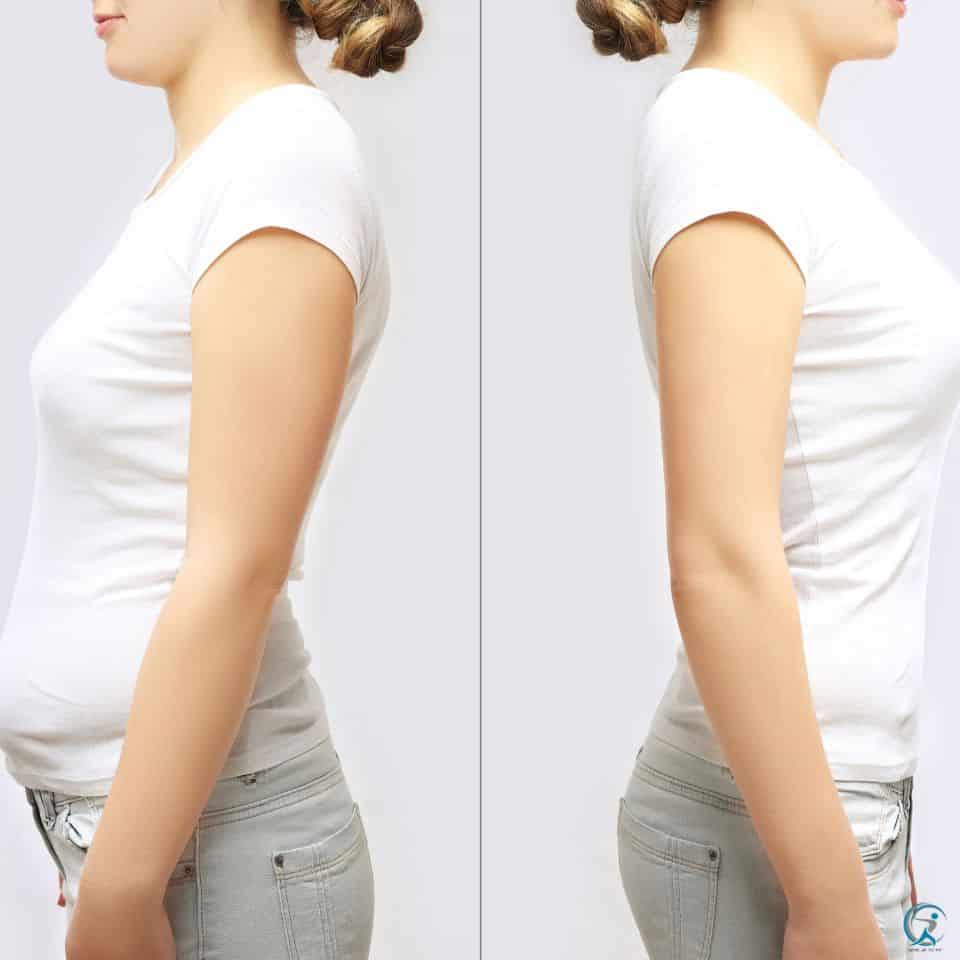
Stretching regularly
One of the most effective ways to improve posture is by stretching regularly. Stretching helps loosen tight muscles and improves flexibility, leading to better alignment and a stronger core.
Incorporating stretching into your daily routine can help prevent injury and relieve stress. Some great stretches for improving posture include the standing hamstring stretch, shoulder blade squeeze, and chest stretch.
To perform the standing hamstring stretch, stand with your feet hip-width apart and slowly bend forward at the waist with a straight back until you feel a stretch in the back of your legs. Hold for 30 seconds and repeat three times.
Sitting
Sitting for long periods can have negative effects on posture, wildly if you’re hunching over a computer or phone. To combat these adverse effects, it’s important to sit correctly. Keep your feet flat on the ground or a footrest, adjust your chair height so your hips are level or higher than your knees, and keep your shoulders relaxed.
Additionally, taking breaks from sitting every 30 minutes can help improve posture. Stand up and stretch or quickly walk around the room before returning to sitting.
Conclusion
Improving posture requires effort both inside and outside of the gym. Combining HIIT workouts with lifestyle changes like stretching regularly and sitting correctly can significantly benefit overall health and improve posture. By consistently incorporating these changes into daily life, individuals can achieve better alignment, reduce discomfort caused by poor posture habits over time, prevent injury associated with poor movement patterns or lack of exercise as well as boost self-confidence by projecting an image of strength through good postural habits which reflects positively in personal interactions both socially and professionally.
As a veteran fitness technology innovator and the founder of GearUpToFit.com, Alex Papaioannou stands at the intersection of health science and artificial intelligence. With over a decade of specialized experience in digital wellness solutions, he’s transforming how people approach their fitness journey through data-driven methodologies.
